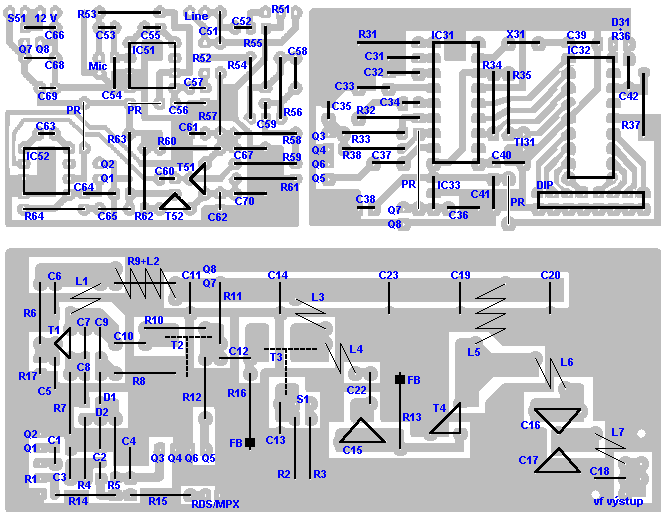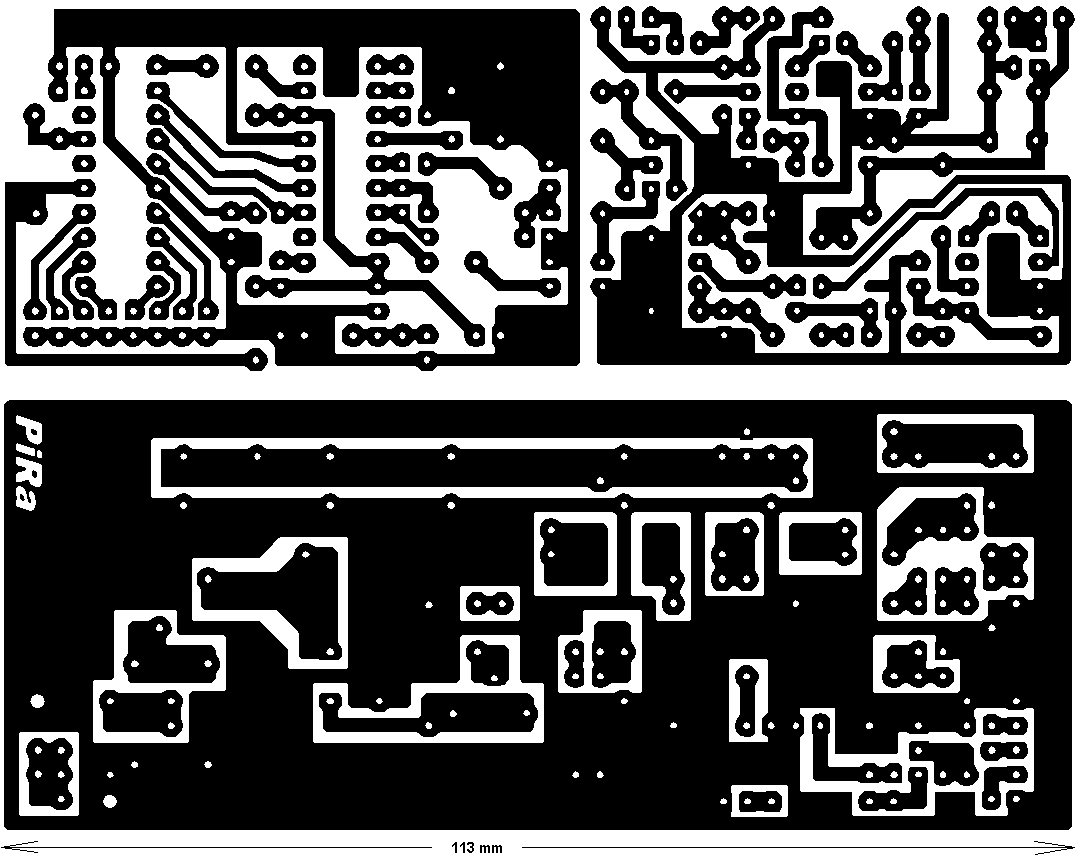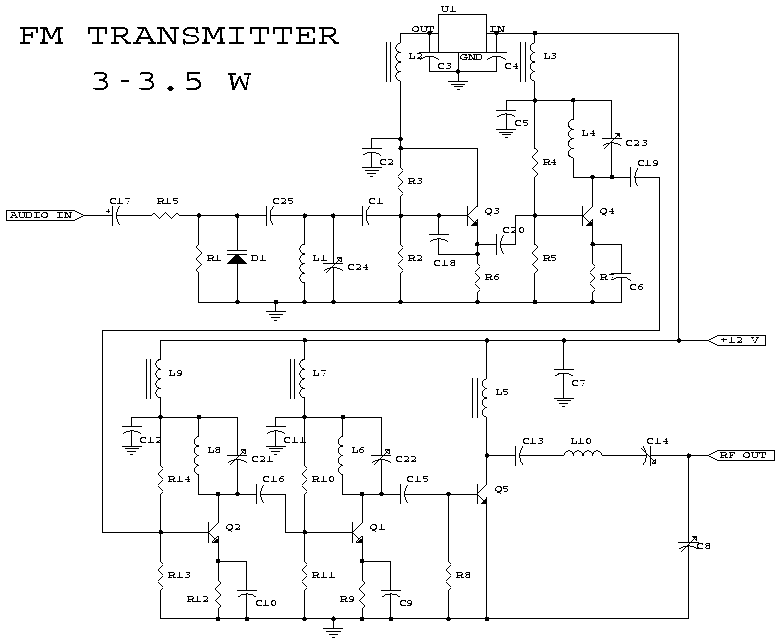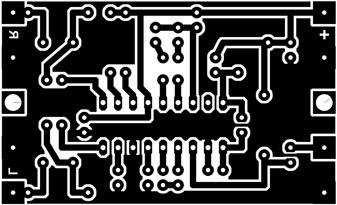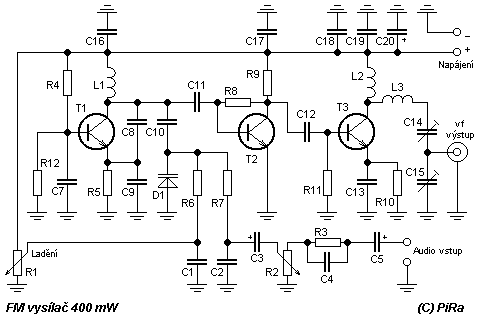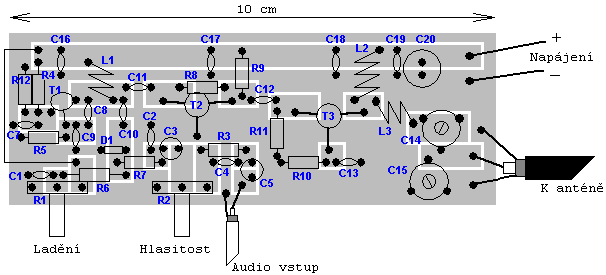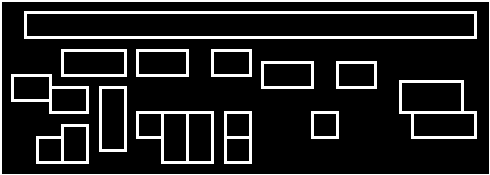This small FM transmitter includes a limiter, a microphone amplifier and a PLL digital tuning. All the parts are placed on one circuit board. The RF power is switchable between 1 W (HI) and 0,2 W (LO).
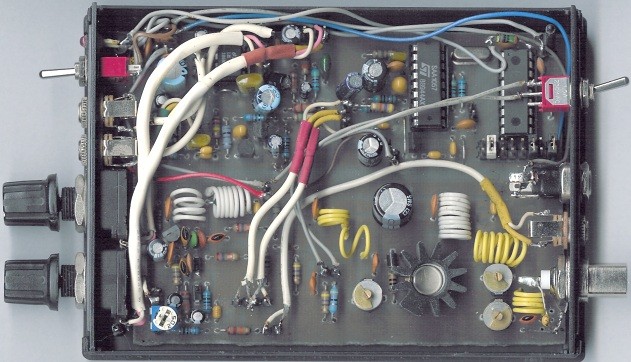
Technical specifications
Supply voltage: 12 V from accumulator or regulated power supply
Supply current (HI/LO): 270/170 mA
RF power HI: 1 W
RF power LO: 0,2 W
Impedance: 50-75 ohm
Frequency range: 87,5-108 MHz
Modulation type: wide-band FM
Modulation inputs: line, mic, RDS/MPX
PCB dimensions: 11,3 x 8,8 cm
RF part 1 W 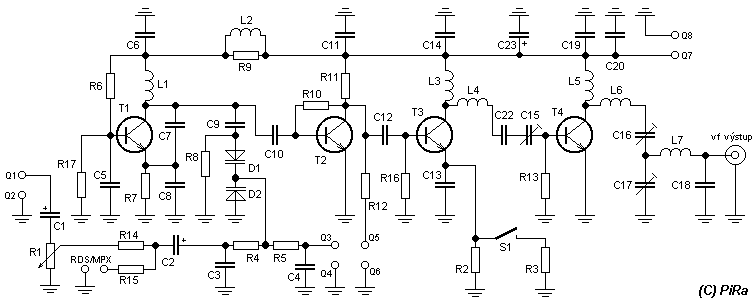
Resistors:
R1 - pot. 5 k
R2, R12 - 1 k
R3 - 220
R4, R8, R10 - 27 k
R5, R6, R14, R17 - 10 k
R7, R16 - 470
R9 - 100
R11 - 270
R13 - 10
R15 - 22 k
Capacitors:
C1 - 4,7 uF
C2 - 1 uF
C3, C4, C12 - 100 pF
C6, C9, C11, C13, C14, C19, C22 - 1 nF
C7, C8 - 10 pF
C10 - 8.2 pF
C18 - 22 pF
C15 - trimmer 47 pF
C16, C17 - trimmer 60 pF
C20, C5 - 100 nF mini
C23 - 470 uF
Coils:
(All coils are free-standing air-core types, wound of 0,7 mm Cu wire, 6 mm internal diameter.)
L1 - 4,5 coils
L3 - 2,5 coils
L4 - 1,5 coils
L2 - 6,5 coils around R9 resistor
L5 - 9,5 coils
L6 - 5,5 coils
L7 - 3,5 coils
Diodes:
D1, D2 - BB109G, BBY31 or BB409
Transistors:
T1 - BC547C (BC548C, BC547B)
T2 - BFR91A (BFR96)
T3 - BFR96
T4 - 2SC1971
Misc:
S1 - switch
PLL digital tuning 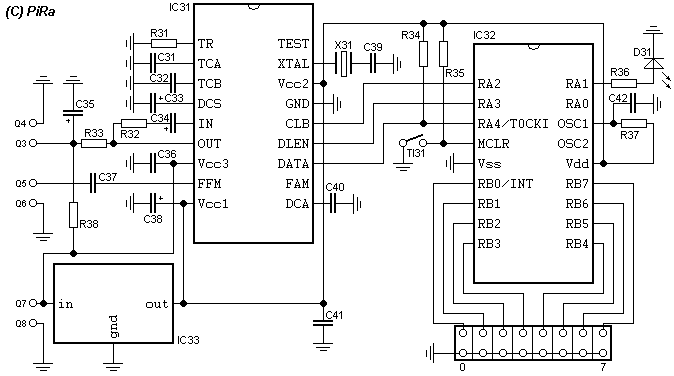
Resistors:
R31 - 1k
R32 - 4k7
R33, R37 - 10k
R34, R35 - 1k
R36 - 470
R38 - 47k
Capacitors:
C31, C42 - 2,2 nF
C32, C40 - 10 nF
C33 - 47 uF
C34 - 10 uF tantal
C35 - 0,47 uF
C36, C41 - 100 nF
C37 - 1 nF
C38 - 220 uF
C39 - 22 pF
Misc:
IC31 - SAA1057
IC32 - PIC16F84-04 + socket
IC33 - 78L05
X31 - 4 MHz crystal
D31 - LED diode
Tl31 - button
Jumpers 2x8 pins or DIP switches
Audio and power supply part
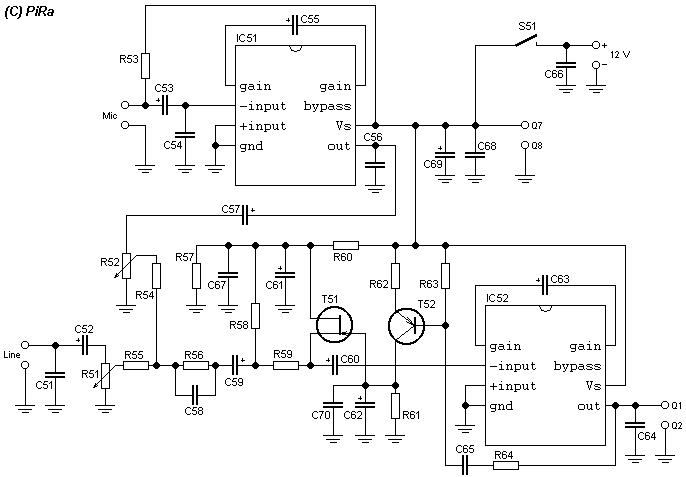
Resistors:
R51, R52 - pot. 5 k
R53, R58, R64 - 10 k
R54, R55 - 22 k
R56 - 56 k
R57 - 1,5 k
R59 - 180 k
R60 - 820
R61 - 10 M
R62 - 47
R63 - 240 k
Capacitors:
C51, C54 - 100 pF
C52, C57 - 2,2 uF
C53 - 1 uF
C55, C62, C63 - 10 uF
C56, C64 - 47 nF
C58 - 1 nF plastic
C59, C60 - 1 uF tantal 25 V
C61 - 100 uF
C65 - 150 nF
C66, C67, C68, C70 - 10 nF
C69 - 470 uF
Misc:
T51 - BF245C
T52 - BC556B
IC51, IC52 - LM386
S51 - switch
Complete parts list
Resistors:
1x 10
1x 47
1x 100
1x 270
2x 220
3x 470
1x 820
5x 1k
1x 1,5 k
1x 4,7 k
9x 10 k
3x 22 k
3x 27 k
1x 56 k
1x 47 k
1x 180 k
1x 240 k
1x 10 M
3x pot. 5 k log.
Capacitors:
1x 8,2 pF
2x 10 pF
3x 22 pF
5x 100 pF
8x 1 nF
1x 1 nF plastic
2x 2,2 nF
5x 10 nF
2x 47 nF
4x 100 nF mini
1x 150 nF
1x 0,47 uF
2x 1 uF
2x 2,2 uF
1x 4,7 uF
4x 10 uF
1x 47 uF
1x 100 uF
1x 220 uF
2x 470 uF
2x 1 uF tantal
1x 10 uF tantal
1x trimmer 47 pF
2x trimmer 60 pF
Semiconductors:
1x BC547C (BC548C, BC547B)
1x BFR91A
1x BFR96
1x 2SC1971
1x BC556B
1x BF245C
2x LM386
1x SAA1057
1x PIC16F84A-04 + socket
1x 78L05
1x Yellow LED 3 mm
2x BB109G, BBY31 or BB409
Misc:
1x 4 MHz crystal
2x switch
1x button
1x jumpers 2x8 pins or DIP switches
1x power supply connector
3x jack 3,5 mm
1x antenne connector
1x plastic case
thin shielded cables
PRINTED CIRCUIT BOARD